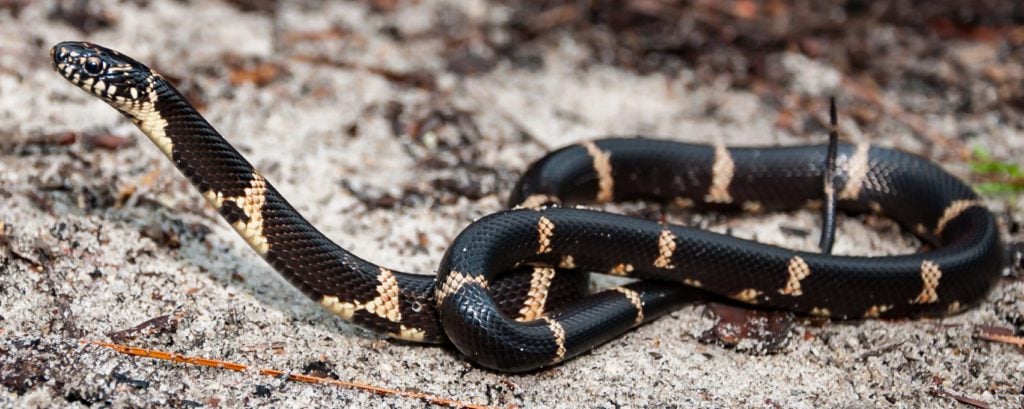3 Types of Kingsnakes in South Carolina! (ID Guide)
Finding kingsnakes in South Carolina can be difficult!

Here’s why:
Most members of the genus Lampropeltis (kingsnakes) spend a lot of their time hidden beneath objects or underground. So while it’s not unheard of, it’s not very common to just stroll past one while walking outside.
Regardless, these non-venomous, mostly docile snakes are fascinating. For example, did you know that kingsnakes EAT venomous snakes? Believe it or not, it’s true!
Today, you’re going to learn about the 3 types of kingsnakes in South Carolina!
-
RELATED: The 34 Types of SNAKES That Live in South Carolina! (ID Guide)
-
RELATED: The 14 Types of Lizards in South Carolina! (With Photos)
#1. Northern Mole Kingsnake
- Lampropeltis calligaster rhombomaculata
Identifying Characteristics:
- Adults range from 30 to 40 inches in length.
- Coloration is gray, light brown, or orangish with black-bordered darker brown, gray, or reddish-brown blotches down its body, which fade with age.
- The head is indistinct from the body, and there is sometimes a dark line through the eye.
- Also called the Brown Kingsnake.
A subspecies of the Yellow-bellied Kingsnake, the Northern Mole Kingsnake prefers open habitats in South Carolina near forest edges. These snakes are difficult to find since they spend most of their time underground in old animal burrows or under logs and rocks. You’re most likely to spot one crossing the road at night.
Northern Mole Kingsnake Range Map

A nocturnal species, the Northern Mole Kingsnake feeds primarily on rodents. However, they’ll also prey on lizards, frogs, and occasionally other small snakes. These snakes are constrictors, and they asphyxiate their prey by coiling around it and squeezing it before consuming it.
The secretive nature of these kingsnakes means that they rarely come into contact with people. They’re non-venomous but may shake their tail as a warning which can sound a bit like a rattlesnake when done in dry leaves. They’re generally quite docile but may bite if grabbed.
#2. Eastern Kingsnake
- Lampropeltis getula

Identifying Characteristics:
- Adults typically range from 36 to 48 inches in length.
- Coloration is shiny black with white or yellow chain-link bands, but some individuals may be entirely black.
- Stout head and small beady eyes.
- Also called the Common Kingsnake.
Eastern Kingsnakes thrive in various habitats in South Carolina!
Look for them in hardwood and pine forests, bottomlands, swamps, and wetlands, as well as farmlands and suburban areas. They are a terrestrial species but are often associated with water preferring riparian habitats along stream banks or marsh edges.
Eastern Kingsnake Range Map

A very secretive species, the Eastern Kingsnake is frequently spotted when moving logs, boards, tin, or other objects they use for cover. They’re constrictors and feed on various types of prey, including rodents, lizards, birds, and turtle eggs. Incredibly, they’re immune to venom from pit-vipers and regularly feed on smaller venomous snakes like copperheads, cottonmouths, and rattlesnakes!
If disturbed, these snakes can mimic rattlesnakes by shaking their tails in dry leaves. They may also release a foul-smelling musk and bite if captured.

Unfortunately, the Eastern Kingsnake has seen dramatic declines in many areas. This is most likely due to habitat loss and degradation, imported fire ants, and disease.
#3. Scarlet Kingsnake
- Lampropeltis elapsoides

Identifying Characteristics:
- Adults typically range from 14 to 20 inches in length.
- Coloration is alternating red, black, and yellow rings encircling the body; the yellow and red rings never touch.
- Small head, barely distinct from the neck and a red snout.
Scarlet Kingsnakes can be found in pine flat woods, pine-oak forests, fields, agricultural areas, and occasionally urban environments. But they are hard to see because they are secretive and mostly stay underground. Look for them under logs, rocks, boards, and other debris. However, they’re also excellent climbers and are sometimes spotted on trees and buildings.
Scarlet Kingsnake Range Map

These vividly colored non-venomous snakes are sometimes mistaken for venomous coral snakes. In fact, they were used as stand-ins for venomous snakes in the movies “Snakes on a Plane” and “The Mummy Returns.”
So how do you tell the difference between a dangerous coral snake and a harmless Scarlet Kingsnake in South Carolina?

Just remember this rhyme and you’ll never have to worry! “If red touches yellow, you’re a dead fellow; if red touches black, you’re all right, Jack.”
These kingsnakes are generally non-aggressive. However, they may vibrate their tail if disturbed, producing a buzzing sound when in leaf litter. If grabbed, they may strike and release a foul-smelling musk.
Do you need additional help identifying a snake?
Try this field guide!
Which of these kingsnakes have you seen before in South Carolina?
Leave a comment below!


